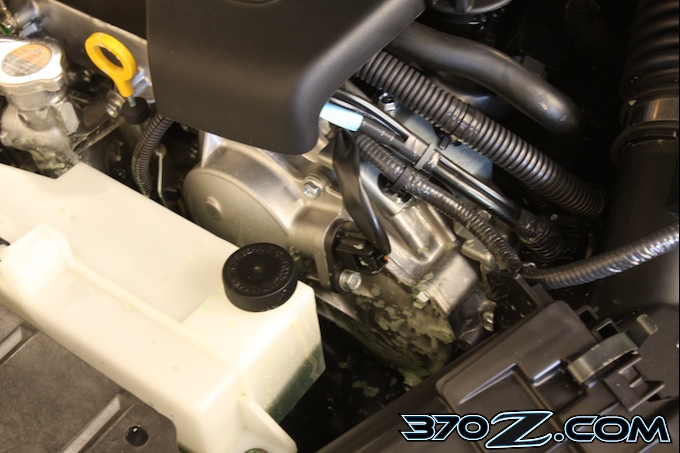Mike Kojima posted on January 02, 2009 06:01

The intake valve opening and closing events are actuated by Nissans VVEL system. This complicated system uses a rotating eccentric activating a rocker arm with a moving fulcrum which can quickly change the motion ratio of the eccentric to the rocker. This gives the ability to steplessly change the duration and lift of the intake valves on the fly. The command authority of this mechanism over valve moment is great enough so that controlling intake valve opening is the primary means of controlling the throttling of the VQ37VHR, instead of the throttle itself.
.jpg) |
| This clear plastic working model might give you a better idea of how the systems works. |
The CVTC phasing control for the intake eccentric (The VQ37VHR has no intake cam per se) shaft is integrated into the intake eccentric shaft sprocket. It consists of a vane equipped inner rotor attached to the intake valve actuating eccentric shaft which is free to rotate within a housing machined into the intake cam gear. A pulse width modulated solenoid controlled by the engine's ECU meters pressurized oil from the engines oil pump to the vaned chamber in the gear. As oil is let into the chamber, it moves the vanes with the engine's rotation and advances the shaft. When the ECU wants to retard the shaft, it meters the oil draining out of the chamber allowing the shaft to retard. By metering the inlet and outlet oil flow, the advance and retard of the intake shafts can be controlled in a stepless manor. The CVTC system has a great deal of control authority over the shafts phasing allowing 36 degrees of movment.
 |
| The 370Z's VQ37VHR engine also uses CVTC and EVTC, tried and true technology that advances and retards the intake and exhaust cams to control overlap. |
The exhaust cams are conventionally fixed in place like the GT-R's VR38DETT. This is unlike the VQ35HR and the Rev Up motor that have adjustable on the fly advancing and retarding for the exhaust cam.
Nissan's complicated system is advantageous from a performance standpoint for being able to optimize the valve events for the immediate driving conditions giving both more power with a wider powerband and excellent drivability. In a simplistic explanation from an enthusiasts point of view, Nissan's valve control systems give the long duration and high lift of a racing cam at high RPM, the good torque and midrange power of a hot street cam at mid RPM's and the smooth idle and crisp drivability of a stock cam at low RPM.
This complication also does big things for efficiency and “green-ness”. Nissan's systems helps reduce emissions by eliminating hydrocarbon spewing, rough running 8 stroking valve overlap at idle and low rpm while keeping the improvements in volumetric efficiency of overlap at the mid rpm range while again reducing overlap for better breathing at high RPM. Nissans valve control systems have the ability to eliminate the EGR valve with early exhaust valve closing; this retains combustion gas in the cylinders to reduce NOX emissions at low RPM and light loads by cooling the combustion temperatures. The engines idle and low speed running stability is also improved greatly at cold start by reducing valve overlap under these conditions. The exhaust valves are opened earlier under these conditions as well. This helps reduce cold start hydrocarbon emissions and speeds catalytic converter light off. Since most of a modern cars total emissions output is produced during cold start, this technology helps the 370Z burn clean with no sacrifice in performance.
The complex valvetrain also greatly helps improve fuel economy in ways beyond the obvious optimization of valve actuation for all driving conditions. The engine's speed and output is largely managed by ECU control of the intake valves, not the throttle bodies. By not having the restriction of the throttle blade at partial throttle, fuel wasting pumping loss is reduced. The engine does have dual drive by wire throttle bodies but they are used only for brake booster vacuum control and quick acting modulation for traction control. Otherwise the throttles are wide open most of the time. By lifting the valves only the amount needed for the load demand placed on them, a lot of mileage robbing friction can be reduced at part throttle. Lift the valves less at part throttle and the eccentric shaft is easier to spin because the valve springs don't have to be compressed as much. The sophisticated valvetrain is the main reason for the 370Z's 1-2 mpg improvement in fuel economy over the 350Z at 18 road and 26 highway mpg respectively despite having a 5.7% increase in displacement and a generous 26 hp improvement in power. It is also responsible for this high performance car having a LEV2 emissions rating.
This is all great high tech stuff but it comes at a price. For us tuners, the valvetrain is going to be difficult to improve and is far beyond the present capabilities of the aftermarket to modify. Even Nissan's factory service manual states that the valvetrain is unserviceable and that the only repair that can be done is to replace the whole head! This means no cams and no way to easily port or modify the head. The only performance solutions are either forced induction or to swap the heads for an earlier version of the VQ although we do not know how easily this is done yet. We suspect this is why this technology was left off of the uber performance flagship Skyline GTR's VR38DETT engine.